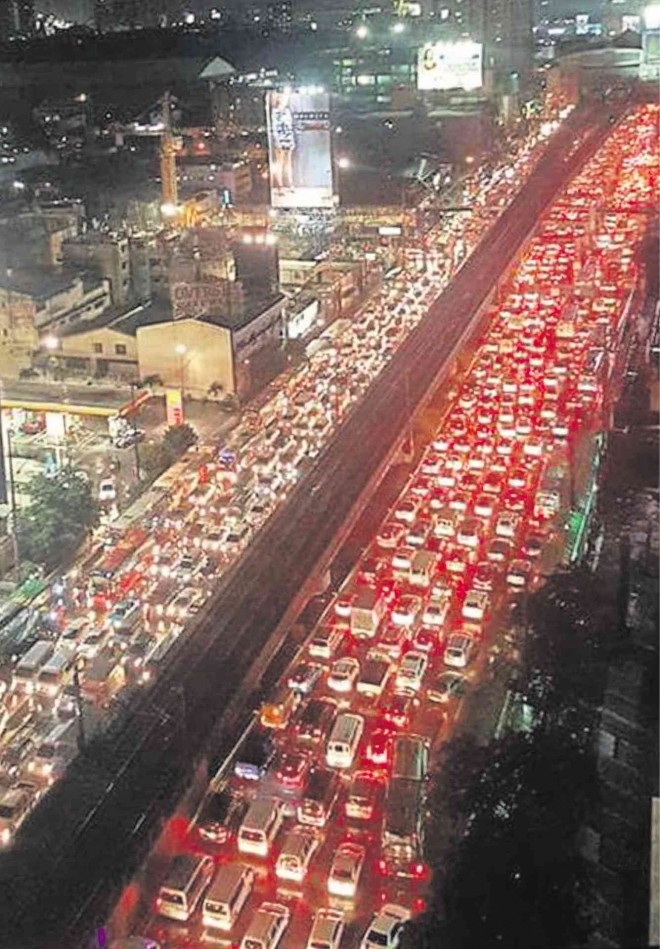Waze users rate Metro Manila traffic world’s worst

Photo taken by Myk Josh Wierzbicki from the 18th floor of Paragon Condominium Plaza on Edsa corner Reliance Street. FILE PHOTO
Metro Manila has earned the dubious distinction of having the worst traffic in the world based on the first “Global Driver Satisfaction Index” (GDSI) developed by traffic and navigation application Waze.
The GDSI results, released on Sept. 29, were derived from Waze’s evaluation of the driving experiences of its 50 million users in 32 countries and 167 metro areas.
GDSI is based on six factors: traffic level by frequency and severity of traffic jams; road quality and infrastructure; driver safety based on accidents, road hazards and weather; driver services like access to gas stations and easy parking; socioeconomic, including access to cars and impact of gas prices; and “Wazeyness,” or the level of helpfulness and happiness within the Waze community.
Each country and metro area have been assigned a score from 1 to 10, with 1 being “miserable” and 10 being “satisfying.”
“On a city level, Manila reported the worst traffic on Earth, with Rio de Janeiro, Sao Paulo, and Jakarta not far behind,” Waze said. Manila scored 0.4 in the traffic index.
Longest commute time
The study also showed that the average commute in Manila lasted up to 45.5 minutes, the longest compared with 18 other cities in the world, such as London, Jakarta and New York City.
Reacting to the Waze index, the Metropolitan Manila Development Authority (MMDA) said a modern and effective mass transit system could help solve the traffic problem in metropolis.
“Other metro cities in the world have efficient mass transit systems, like the London Tube and the New York Subway System. Subways will solve our problems,” said MMDA Chair Francis Tolentino, who has declared his intention to run for senator in the 2016 elections.
Presidential Communications Secretary Herminio Coloma said short- and long-term measures were being put in place by the government to improve the traffic situation in the metropolis.
“What is important is our determination to improve the situation and pinpoint the problem and identify the solution,” Coloma said.
Economic losses
Economic losses due to the congestion in Metro Manila was estimated at P2.4 billion a day and could rise to P6 billion a day by 2030 if the government fails to intervene, according to a study by the Japan International Cooperation Agency (Jica).
The losses do not include the impact of pollution from motor vehicles on the health of residents of the metropolis.
Tolentino earlier said that a subway system, which he claimed would be part of the “leapfrogging of the mass transit system,” would greatly help in easing traffic congestion in the metropolis.
Subway
He said Jica had found that a subway in Metro Manila was “economically viable.”
The establishment of a mass subway system is part of the P2.3-trillion transportation infrastructure plan (dream plan) for the metro. It was presented to the Cabinet by Jica in February.
The subway line, which according to Jica will range from 40 to 70 kilometers and will connect Bulacan to Cavite, is expected to be done in phases to further enhance its economic benefits.
Worst country
On the national level, the Philippines is also the worst country in terms of traffic and socioeconomic indices, and one of the worst in the Wazeyness index.
The bad traffic numbers are somehow offset by the ranking of the country in the GDSI’s safety and driver services indices in which the Philippines ranked among the world’s best.
The Netherlands, despite being one of the most densely populated countries in the world, is said to be the best place to be a driver and has the least amount of traffic among all the other countries included in the study.
Flooded streets
For Ivy Malicay, a 33-year-old BPO specialist, the Waze mobile application is a reliable way to get from one destination to another, especially if you are not familiar with the routes.
Aside from giving her the fastest travel option, Waze also provides her other possible routes which she can choose from, she said.
Flood-watch app
Malicay, however, said that the problem with the application was that it sometimes led her to flooded streets. She suggested that a flood watch-application be incorporated in the application.
Sheremie Samson said she used Waze to guide her when riding taxis and prevent her from being fooled by devious drivers. Waze gives passengers an idea if taxi drivers are bringing them to the right and most efficient route, she added.
Real-time users’ data
For Chad Osorio, a law student who has been using Waze usually for out-of-town trips, the Waze application’s real-time data submitted by users allowed drivers to avoid the “hassle” traffic. “The problem, however, is when your net connection sucks, and if you’ve become too reliant on it, it becomes hard to navigate already,” he said.
Also, there are instances when Waze provides inaccurate road directions that lead to longer route.–With reports from Jerry E. Esplanada, Jodee Agoncillo and Inquirer Research
Originally posted as of 10:46 AM | Thursday, October 1, 2015
RELATED STORIES
Developers, mall owners offer traffic solutions
Traffic-free Metro Manila? Senate hears dream plan














